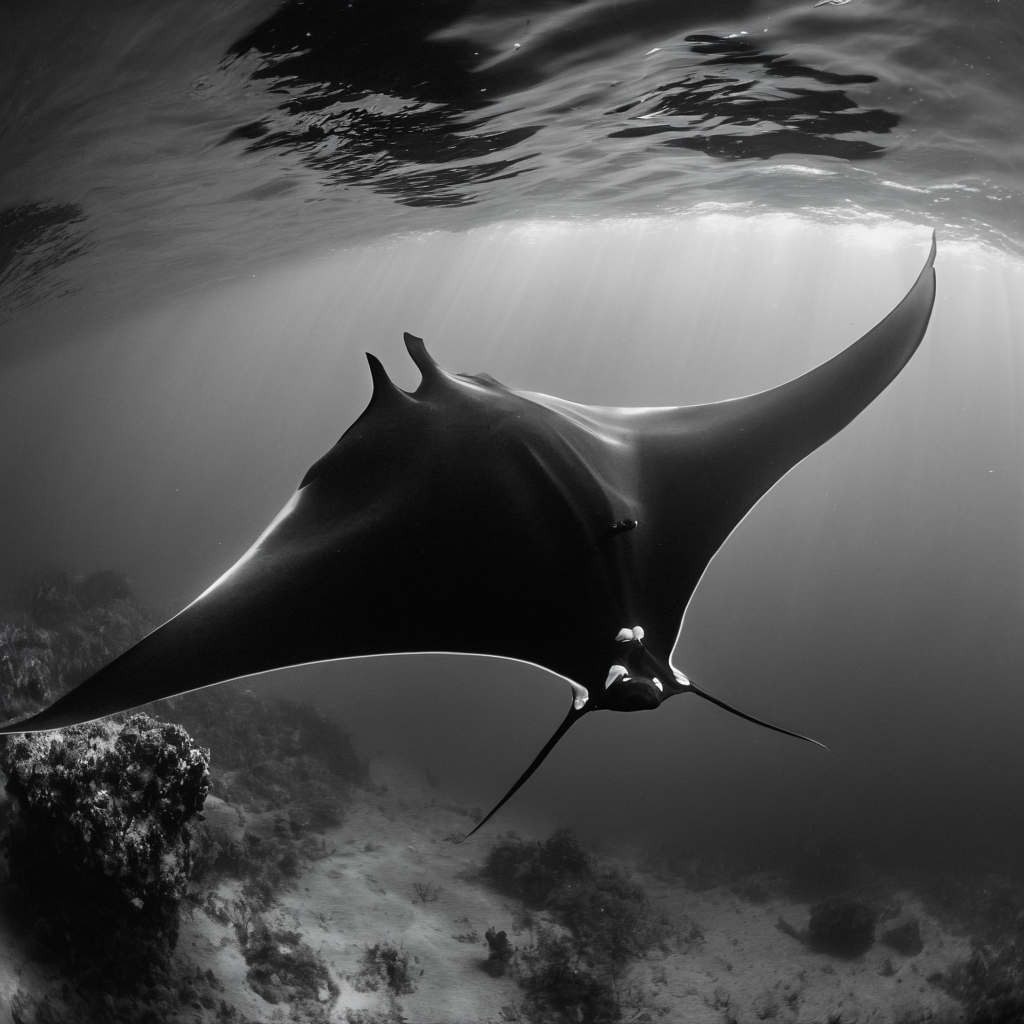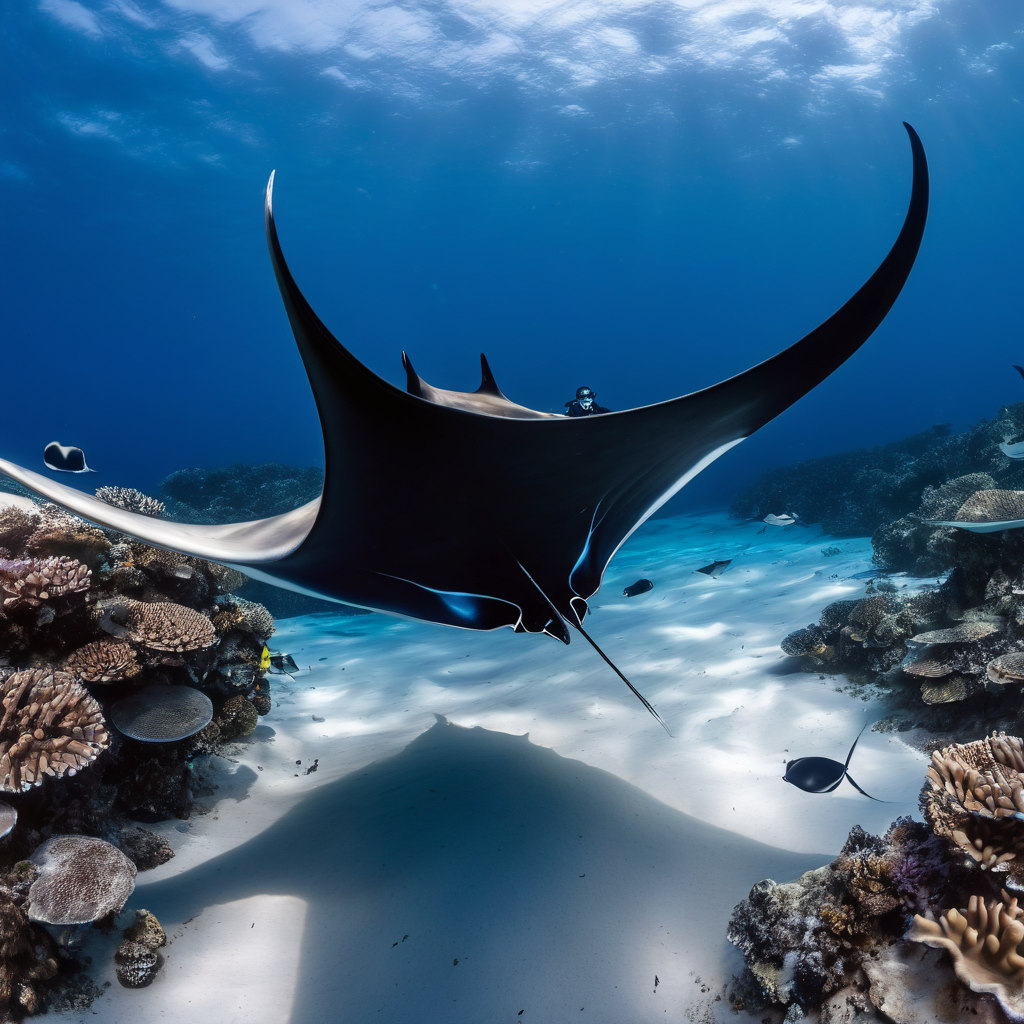Manta rays, the graceful giants of the ocean, have captivated scientists and enthusiasts for years. This article explores the question of how many species of manta rays exist. Through recent discoveries and ongoing research, we uncover the secrets of these magnificent creatures, highlighting their diversity and the need for conservation.
Table of Contents
Meet the Manta Rays
Introduction to Manta Ray Species
Manta ray species have long held a special place in the hearts of marine enthusiasts and conservationists. These majestic creatures, characterized by their distinctive triangular pectoral fins and the sense of grace they exude as they navigate the ocean’s depths, are both captivating and enigmatic. In our quest to understand the diverse world of manta ray species, we embark on a journey that begins with an introduction to these remarkable marine animals.
From their impressive size to their complex behaviors, manta rays beckon us into their realm, and it is within this chapter that we will lay the foundation for unraveling the mysteries of their existence. Manta rays are fascinating marine creatures, there are two primary species of manta rays:
- Manta Birostris: Also known as the Giant Oceanic Manta Ray, this species is the larger of the two and can be found in tropical and subtropical waters around the world.
- Manta Alfredi: Commonly referred to as the Reef Manta Ray or the Spotted Manta Ray, this species is slightly smaller and tends to be associated with coral reef environments.
It’s important to note that the common names for manta rays can vary regionally, and there may be ongoing taxonomic research that could result in more distinct species being identified in the future. Nonetheless, these two species are the most commonly recognized and encountered by divers and researchers.
Their Iconic Features
Manta ray species are renowned for their iconic features, which make them instantly recognizable in the underwater world. Their wingspan, which can reach up to 23 feet, is a defining characteristic that leaves divers and scientists in awe of their sheer size. Manta rays’ flattened, diamond-shaped bodies are adorned with striking patterns and colorations, setting them apart as some of the ocean’s most elegant inhabitants. Beneath these gentle giants lies a world of complexity, from their elaborate gill structures to their unique mouths adapted for filter-feeding. In this chapter, we explore the iconic features that make manta rays a subject of fascination and the object of research and conservation efforts.
The Importance of Studying Manta Ray Species
Studying manta rays is crucial for marine biology and conservation. These charismatic creatures offer insights into ocean health and help scientists assess environmental impacts. Understanding their behaviors and diversity is essential for their protection and broader marine conservation efforts. This chapter explores the significance of manta ray research in securing their future in our oceans.
Current Understanding of Manta Ray Species
Historical Perspectives
Over time, historical perspectives on manta ray species have evolved, from awe and trepidation to informed fascination. Initially seen as mythical creatures associated with good fortune or sea monsters, our understanding grew through exploration and scientific discovery. Pioneering marine biologists and naturalists identified key characteristics, behaviors, and habitats, paving the way for modern research and conservation efforts. This historical journey provides essential context for our current knowledge of manta ray species.
Taxonomy and Classification
The taxonomy and classification of manta rays have been revised as scientific knowledge advanced. Manta rays and devil rays belong to the Mobulidae family, but recent research has led to a better understanding of their differences. Manta rays are part of the Manta genus, while devil rays are part of the Mobula genus. Identifying and categorizing specific species within the Manta genus is currently the focus of ongoing research, using genetic and morphological analyses. This updated classification is crucial for conservation efforts.
Known Manta Ray Species
The understanding of manta ray species is evolving due to ongoing research and genetic analysis. Previously, only two species were recognized, but recent studies suggest the existence of additional distinct species within the Manta genus. This expanding list emphasizes the need for continued research and conservation efforts to fully comprehend the diversity and conserve these creatures.
Recent Discoveries and Ongoing Research
The Quest for New Species
The search for new manta ray species has driven marine biologists to explore remote and unexplored areas of the oceans. These expeditions aim to discover and document new species, understand their ecological roles and distribution patterns, and protect their populations.
Genetic and Morphological Studies
Genetic and morphological studies are essential for understanding manta ray diversity. Genetic analyses help researchers identify genetic variations among manta ray populations, shedding light on their evolutionary history and the possibility of distinct species. Morphological studies focus on physical characteristics like coloration patterns, denticle arrangements, and gill structures, providing insights into potential variations among manta ray species. By combining these approaches, scientists can gain a comprehensive understanding of manta ray species and discover new ones.
Field Research and Observations
Field research and observations are crucial for studying manta ray species in their natural habitats. Scientists undertake expeditions to document behaviors, movements, and interactions with other marine species using underwater technology like ROVs. These studies help gather data on known manta ray species and may lead to the discovery of new species. Cataloging behavioral patterns, migratory routes, and habitat preferences is essential for scientific documentation and understanding manta rays.
Challenges in Studying Manta Ray Diversity
Elusive Nature of Manta Rays
The mysterious behavior of manta rays, including their stealthy movements and concealed reproduction, poses challenges for scientists and conservationists. Studying their life cycle, migration, and seasonal behaviors requires extensive research, underwater technology, and patience. Continued scientific exploration is crucial to uncovering the secrets of these fascinating creatures and ensuring their conservation.
Conservation Implications
Understanding manta ray diversity is crucial for conservation. Researchers are identifying new species, which emphasizes the need to protect them. Each species has unique ecological preferences and faces specific threats, requiring tailored conservation strategies. Manta rays are keystone species in marine ecosystems, and their conservation involves protecting habitats, reducing bycatch, and promoting sustainable practices. Safeguarding these creatures and their ecosystems is imperative.
Environmental Threats
Manta ray species are threatened by overfishing, habitat degradation, pollution, climate change, and ocean acidification. These environmental threats highlight the need for conservation efforts and sustainable practices to protect them and maintain ocean health.

The Ecological Significance of Manta Ray Species
Manta Rays as Keystone Species
Manta rays are vital keystone species in marine ecosystems. By consuming plankton and small fish, they regulate populations and influence the distribution of these organisms. This cascading impact affects the entire food web, making manta rays crucial for maintaining the ecological balance and sustaining marine life.
Impact on Marine Ecosystems
The presence of manta ray species has a profound impact on marine ecosystems. They contribute to nutrient cycling, water clarity, and reducing algal blooms. Additionally, their fecal plumes enrich the marine environment, supporting diverse ecosystems. Manta rays also contribute to ecotourism and generate revenue for coastal communities, promoting conservation and sustainable practices. Their presence highlights their significance in preserving marine ecosystems.
The Interconnected Ocean
The interconnectedness of the ocean’s ecosystems is a fundamental ecological principle, and manta ray species exemplify the intricate web of relationships that span these underwater worlds. These gentle giants move through vast oceanic expanses, connecting disparate ecosystems and facilitating the exchange of nutrients, energy, and species.
Their migratory patterns not only affect the abundance of prey species but also serve to redistribute nutrients through fecal plumes, enriching the waters they traverse. In doing so, manta ray species foster the health of coral reefs, sea grass beds, and other critical marine habitats, benefiting a multitude of species along the way.
This interconnection is a reminder of the delicate balance within the oceans, and it underscores the importance of preserving manta rays and their habitats. The conservation of these magnificent creatures is, in essence, a pledge to safeguard the integrity and interconnectedness of the world’s oceans.
Conservation Efforts and Future Prospects
Initiatives to Protect Manta Rays
Initiatives to protect manta rays have gained momentum globally. Conservation organizations, governments, and communities have established marine protected areas (MPAs) where fishing is restricted or banned, providing safe havens for these species. International agreements like CITES regulate the trade of manta ray products, such as their gill plates, ensuring their conservation. These efforts demonstrate a global commitment to safeguarding these magnificent animals.
Sustainable Practices
The conservation of manta ray species hinges on adopting sustainable practices in the realms of fishing, tourism, and marine resource management. Fisheries have been implementing catch limits and regulations to prevent overfishing, focusing on responsible and ethical practices that respect manta ray populations. In the world of ecotourism, many regions now promote responsible wildlife encounters that prioritize the well-being of the animals and their habitats.
Eco-friendly guidelines and codes of conduct help ensure that manta ray tourism has a minimal ecological footprint. Furthermore, engaging with local communities in manta ray conservation efforts is crucial. Sustainable practices extend beyond marine biology, creating a holistic approach that takes into account the long-term preservation of manta ray species while supporting the well-being of coastal communities. This balance is vital to ensuring that manta ray conservation is both environmentally and socially sustainable.
The Ongoing Quest for Knowledge
The ongoing quest for knowledge about manta ray species remains a central pillar of their conservation. Marine biologists and scientists continue to conduct research, expanding our understanding of these magnificent creatures. Genetic studies help discern the differences between various manta ray species and uncover potential new ones.
Advanced technology, such as satellite tagging, is employed to track their movements and migratory patterns, offering insights into their behavior. Field research and underwater observations provide valuable information about their feeding habits, reproduction, and social interactions. This relentless quest for knowledge not only deepens our appreciation for the intricacies of manta ray species but also plays a critical role in driving effective conservation strategies. The desire to unravel the mysteries of these creatures fuels the dedication of researchers, propelling manta ray conservation efforts into the future.
Conclustion
Unveiling the Diversity of Manta Ray Species
The quest to unveil the diversity of manta ray species continues to be a journey marked by discovery and wonder. With each new species identified, we gain a deeper understanding of the intricate tapestry of life beneath the ocean’s surface. The genetic, morphological, and ecological research dedicated to manta rays reveals that the vastness of the ocean harbors secrets that are yet to be fully unraveled.
The diversification within the Manta genus highlights the need for continuous exploration and the importance of safeguarding these newly discovered species. Unveiling the true extent of manta ray diversity is not only an achievement for marine science but also a testament to our evolving relationship with the oceans. It underscores our responsibility to protect these remarkable creatures, ensuring that their presence continues to inspire awe and appreciation for the interconnected marine world they represent.
Embracing the Wonder of the Oceans
As we embark on the journey to understand and conserve manta ray species, we also embrace the wonder of the oceans themselves. The revelation of diverse manta ray species is just one facet of the intricate mosaic of marine life.
It serves as a reminder of the boundless beauty and mystery that our oceans hold. Manta rays, with their elegance and grace, are emblematic of the countless captivating species that call the seas home. Their conservation and protection resonate with the larger imperative of preserving the oceans and all their inhabitants.
Embracing the wonder of the oceans is an invitation to explore, respect, and cherish the vibrant ecosystems that underpin our planet’s health and prosperity. It is a call to embark on a journey of discovery, conservation, and stewardship to ensure that the oceans’ mysteries continue to inspire generations to come.
Related Articles
Click here to read our article “Are Manta Rays Dangerous? Demystifying the Danger Beneath the Waves”.
